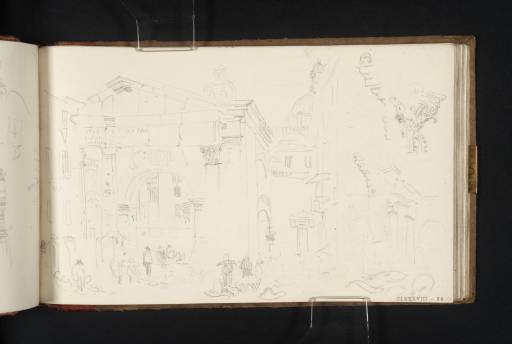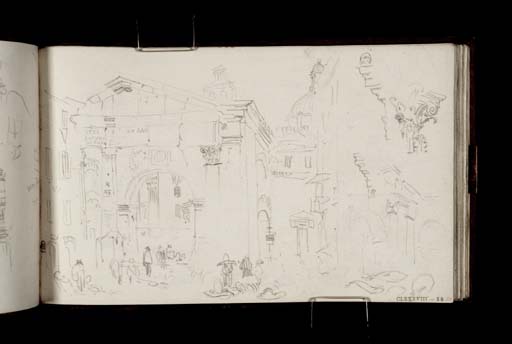Joseph Mallord William Turner The Portico of Octavia, Rome 1819
Image 1 of 2
Joseph Mallord William Turner,
The Portico of Octavia, Rome
1819
Joseph Mallord William Turner 1775–1851
Folio 51 Recto:
The Portico of Octavia, Rome 1819
D16245
Turner Bequest CLXXXVIII 50
Turner Bequest CLXXXVIII 50
Pencil on white wove paper, 114 x 189 mm
Inscribed by the artist in pencil ‘W’ on building far left and ‘PIVS | ANTONI | IV CRNO’ and ‘XXANC’ along frieze of pediment
Inscribed by John Ruskin in red ink ‘50’ bottom right
Stamped in black ‘CLXXXVIII 50’ bottom right
Inscribed by John Ruskin in red ink ‘50’ bottom right
Stamped in black ‘CLXXXVIII 50’ bottom right
Accepted by the nation as part of the Turner Bequest 1856
References
1909
A.J. Finberg, A Complete Inventory of the Drawings of the Turner Bequest, London 1909, vol.I, p.559, as ‘Pediment of the Portico of Octavia’.
1984
Cecilia Powell, ‘Turner on Classic Ground: His Visits to Central and Southern Italy and Related Paintings and Drawings’, unpublished Ph.D thesis, Courtauld Institute of Art, University of London 1984, pp.109, 112, reproduced fig.35, as ‘The Portico of Octavia’.
1987
Cecilia Powell, Turner in the South: Rome, Naples, Florence, New Haven and London 1987, p.37, reproduced p.[36] pl.32, as ‘The Portico of Octavia’.
The remains of the Portico of Octavia (Porticus Octaviae) stand near the Theatre of Marcellus in Rome. Built in honour of the sister of the Emperor Augustus, the portico is the only surviving part of a larger piazza which housed temples and other buildings. Turner’s sketch depicts the main entrance of the structure, characterised by a large arch added to the portico during the Middle Ages which disrupted the classical symmetry of the remaining columns.1 On the right-hand side of the page he has also drawn several separate studies of individual architectural elements such as the entablature and the Corinthian capitals. The view is similar to that depicted by Piranesi (1720–1778) in his etching, Veduta dell’Atrio del Portico di Ottavia from the Veduta di Roma,2 and Giuseppi Vasi’s, Piazza di Pescaria, from Book II of Sulle Magnificenze di Roma Antica e Moderna (1752).3
The dome and cupola in the background on the right belongs to the Church of Santa Maria in Campitelli but the building just visible beyond the main arch is Sant’Angelo in Pescheria, an eighth-century Church which incorporated part of the Roman ruins into its southern end.4 The name literally translates as the ‘Holy Angel in the Fish-market’ and commemorates the fact that between the third century AD and the end of the nineteenth century the Portico of Octavia housed the city’s principal fish market. The bustle of everyday working life within the shadow of the decaying ancient remains represented a colourful spectacle for nineteenth-century visitors to Rome and amongst the painters who treated the subject were Turner’s contemporary Samuel Prout (1783–1852), The Fishmarket at the Portico of Octavia, watercolour, c.1824 (Museo di Roma) and the German-American painter Albert Bierstadt (1830–1902), Roman Fish Market, Arch of Octavius 1855 (Fine Arts Museums of San Francisco, California). In this sketch, Turner too has drawn some of the traders selling their wares in the foreground. Further related views can be found on folios 51 verso and 52 (Tate D16246 and D16247; Turner Bequest CLXXXVIII 50a and 51).
In addition to the fish-market, the Portico of Octavia is noted as the centre of the Jewish quarter of Rome. The Synagogue, built in 1874, stands in close proximity. Until the unification of Italy at the end of the nineteenth century the Roman Jewish population were confined within this designated ghetto and forced to attend compulsory Christian services in Sant’Angelo in Pescheria. Charlotte Eaton, who visited the city two years before Turner, described the poor conditions of the district in her travel journal, first published in 1820:
The remains of the Portico of Octavia stands in what I am convinced is the filthiest spot upon the whole face of the globe. It is the Pescheria, or fish market:– the Ghetto, or crowded quarter where the Jews, whatever be their number, are condemned to reside; and while miles of uninhabited ground are comprised within the walls of Rome – while it becomes yearly more insalubrious from its desertion, and more deserted from its insalubrity – these poor Israelites are cooped up in a confined hole, the dirt, the stench, and the disgusting appearance of which, it is utterly impossible to conceive.5
Nicola Moorby
September 2008
How to cite
Nicola Moorby, ‘The Portico of Octavia, Rome 1819 by Joseph Mallord William Turner’, catalogue entry, September 2008, in David Blayney Brown (ed.), J.M.W. Turner: Sketchbooks, Drawings and Watercolours, Tate Research Publication, December 2012, https://www


